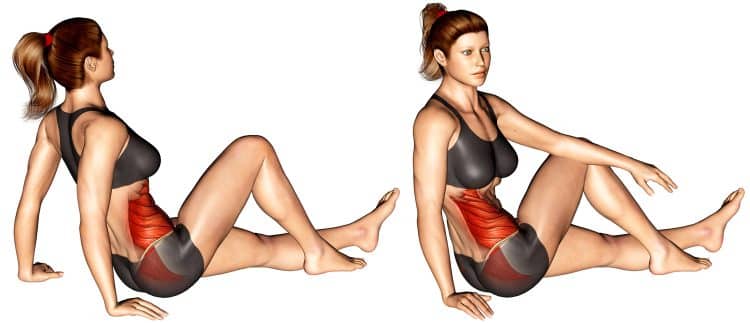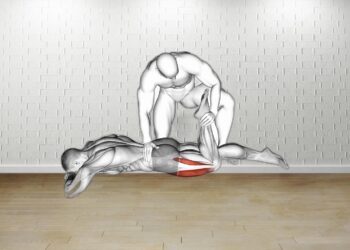Before you get too excited you won’t actually be eating any pretzels during this stretch but you will look a little bit like one if it’s done properly. The pretzel stretch is not to be feared though, it’s actually a simple, usually pain-free technique to stretch glutes, obliques, and back muscles.
It does require a little flexibility to get into position and perform the pretzel stretch properly and this guide will explain the how-to, benefits, variations, and more.
How To Do The Pretzel Stretch
First, drive to the nearest store and grab a bag of your favorite pretzels… just kidding.
Before performing the pretzel, we recommend doing a few minutes of light physical activity to warm up the muscles of the core and lower body beforehand. This is to ensure your muscles are elastic and pliable which is ideal for safe and effective stretching sessions.
Below we’ve included step-by-step instructions for performing the pretzel stretch.
To do it:
Level Up Your Fitness: Join our 💪 strong community in Fitness Volt Newsletter. Get daily inspiration, expert-backed workouts, nutrition tips, the latest in strength sports, and the support you need to reach your goals. Subscribe for free!
- Start from a sitting position on the floor with your legs extended out in front of you.
- Bend your left leg and place it on the other side of your right leg.
- Keep your left arm extended on the floor for balance, then place the right arm against the outside of your left leg/knee.
- Tense your core muscles, then twist your body to the left until you feel a stretch in the glutes and back muscles. Hold this position for 10-15 seconds.
- Now return to the starting position with both legs extended, cross your right foot over the left leg and switch the arm position to stretch the opposite side.
Repeat the stretches a few times if needed.
Watch the following video demonstration of the pretzel stretch in action.
Pretzel stretch tips and tricks
There are a few things you should know to ensure you perform the pretzel stretch safely and effectively.
- Performing the pretzel stretch may cause your back to crack. This is not an issue, however, we do not recommend applying excessive force during the stretch as this could be bad for your back.
- Remember that the bent leg is the one being stretched.
- It’s important to keep your body fully relaxed when performing most stretches as it allows the muscles fibers to be adequately stretched.
3 Pretzel Stretch Benefits
Stretching has been shown to have numerous benefits on the body and mind. But each stretch is different and will therefore have its own unique benefits. Here are a few reasons to include the pretzel stretch in your weekly health maintenance regime.
Relieve tight muscles
Muscle tension can be very uncomfortable but because of modern lifestyle habits such as sitting for most of the day, heavy physical activity, or even injuries, it’s unavoidable. But that’s why preventative and therapeutic maintenance is very important. Stretching out weekly can make you feel so much better overall.
Maintain healthy joint movement
Muscles and joints work in tandem to allow us movement in our body parts. But tight or shortened muscles limit the range of motion in our joints, which prevents healthy, proper movement and that’s when we become more prone to injuries.
Very simple – no excuses
There’s not much to the pretzel stretch, although you’d think there would be if you’re contorting your body to resemble a twisted snack food. But don’t let the name intimidate you. If you have healthy mobility in your hips and a basic level of flexibility, this technique is a good option for you.
Drawbacks
Are there any drawbacks to such a simple stretch? Possibly.
Requires decent hip mobility and upper body flexibility
It’s true that not every stretch or exercise is for everyone. Well, the same goes for the pretzel stretch. Some people simply don’t have much mobility in their hip joint to comfortably cross one leg over the other, or a flexible enough waist to twist and hold their torso to get a good stretch.
Level Up Your Fitness: Join our 💪 strong community in Fitness Volt Newsletter. Get daily inspiration, expert-backed workouts, nutrition tips, the latest in strength sports, and the support you need to reach your goals. Subscribe for free!
It’s also good to maintain a somewhat upright torso which may mean having some core strength. All in all though, the pretzel stretch seems to be a safe exercise for most people who do it properly.
Too much force
It’s perfectly fine to apply decent pressure during the pretzel stretch, however, we don’t recommend doing this excessively. You should feel a good stretch in the target muscles, but if you’re straining or feel pain then you’re doing it wrong.
Variations and Alternatives
While the pretzel stretch is a great stretch because of its simplicity, we also like these variations that may have some advantages or may be preferred over the basic pretzel stretch technique.
Lying pretzel stretch
Variations are great because if you don’t like one or if it doesn’t feel best for you then you can do another. The lying pretzel stretch is performed exactly as it sounds, on your side, and many will feel it much better because of how the body is positioned. It’s also a little more complex compared to the basic pretzel stretch.
To do it:
- Lie on your right side, then cross your left (top) leg over your right (bottom) leg.
- Bend your right (bottom) knee to bring your foot behind you then grab and hold it with your left hand.
- Lie flat on your back so that you’re facing the ceiling and pull your left leg down toward the floor with your right hand until you feel an amazing stretching in your leg butt muscle.
- Hold this for 10-20 seconds then switch sides and repeat.
- To stretch your right glute, turn in the other direction, cross your right leg over your left, then bend your left foot back and pull down on your right leg with the left hand.
Another method is to lie on your back with both knees propped up. You’ll then place one leg over the other to hold it in place, and then pull that leg to the opposite shoulder.
Note: This variation is shown as the second exercise in the same video demonstration of the pretzel stretch included above under the exercise instructions.
Different version of pretzel stretch
Lying knee to chest stretch
One alternative to the pretzel stretch is the lying knee to chest stretch. It’s as simple as lying on your back and pulling your knees into your chest one at a time. It’s a hip flexor focused stretch but it’s a good option to loosen up the glutes and lower back.
Muscles Involved
Below we’ve included the primary muscles involved in the pretzel stretch.

Gluteus medius
Most people don’t know their butt has three main muscles – gluteus maximus (largest muscle in the butt and body), minimus (smallest of the three) and medius (found between maximus and minimus). It’s a hip adductor muscles that pull the leg in toward the center of the body but it also works in conjunction with minimus to internally rotate the thigh.
Obliques
Second to the rectus abdominis or abs in popularity, the oblique are also an important core muscle that rotate, laterally flex (bend to the side), and stabilize the trunk.
Erector spinae
Back extensor muscles line the length of the spine and make it possible to bend over and backwards. They also work with the obliques to flex the trunk from side to side.
Bottom Line
The pretzel stretch is just one of the many effective techniques used to help maintain healthy muscles, range of motion in the joints, and general well-being. There’s not much to it but it is a simple and convenient method to either maintain or increase flexibility in the core and glutes.
Also make sure to include the variations as they’ll allow you to take this stretch a little further (pun intended).








